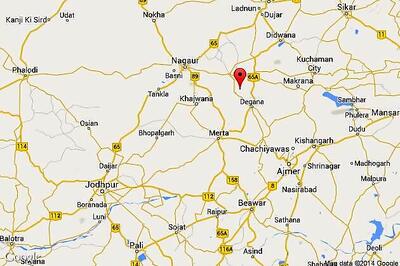
views
The beach worshippers of Mumbai and Delhi constantly fail to appreciate the civilisational basis of Goa, perhaps one of contemporary India's biggest global brands. This little strip of land where the Portuguese raced around amassing fortunes, persecuting Hindus and building grand churches is not just a pleasure spot. Instead Goa is a living example of a homegrown rooted cosmopolitanism. 450 years of Portuguese rule, however brutal, has somehow created a unique geographical and cultural space. "Ami Bhau" (we are brothers) or a no-nonsense everyday togetherness prevails in the communidades or village communities of Goa. An unfussy robust secularism, far away from the posturings at elite seminars, has made its way into the earth of Goa. Hindu and Catholic rarely intermarry yet a quaint totally tolerant spirit lives and breathes in the wayside shrines of Goa. Candles burn in front of a cross, there are hibiscus flowers at the feet of a little Shiva just next to it. Jagor or folk music is played by both communities and tiatr or folk drama is participated in by Hindus as well as Christians.
The Goan office, as social scientist Peter Ronald D'souza pus it, is a prime example of Goan coexistence. The Hindu lady wears a sari and the catholic lady wears a dress, but their body language, their gestures, they way they relate to each other is so comfortable that its hard to imagine they worship different gods. Goa has the Uniform Civil Code, and each community is highly religious. Secularism does not come at the cost of religion, secularism does not mean scorn or disrespect. Instead the secularism of Goa is holy, it is full of religion, it is commonsensical and it is everyday. It exists in the Konkani language that is spoken by all communities and it exists in the fact that the 30 per cent Catholic population has only rarely felt threatened by the Hindus. Tolerance is just there. Narendra Modi would probably meet his Waterloo in Goa.
The rise of the BJP did produce some communal polisarisation in Goa. In the Sanvordem- Curchorem riots in 2006, the homes and shops of local Muslims were attacked and many observers said that the riots were a direct result of the propaganda unleashed by sangh outfits. Yet when he was Chief Minister Manohar Parikkar was able to only make token saffron gestures. All he was able to do was publicized a CD that hurt the sentiments of the Catholics and there were reports of "saffronisation" of primary school education. The BJP government could not resort to hard hindutva and the saffronisation of Madhya Pradesh or Gujarat is still foreign in Goa. Today Parikkar remains an immensely popular leader both among Hindus and Christians, and particularly among the young, and an argument can be made that if only the BJP has been more intelligent in its alliances, it would have won this election. The fact that leaders like Parikkar have had to downplay their saffron leanings and focus squarely on development means that for the moment the Goan spirit has tamed the communal agenda of the BJP. In Punjab, the Sikh clergy cannot tolerate religious diversity and seeks to shut down the Dera Sacha Sauda. In Gujarat, artists are put behind bars. But in Goa, diversity exists in the very DNA of the state and whoever destroys it, whoever reduces its importance, will be destroying not just Goa but a precious island of homegrown Indian cosmopolitanism and a certain native sophistication.
There is another important lesson for India that Goa holds. To destroy the land economy of Goa would destroy its deep cultural heritage. Once the rich of Mumbai and Delhi used to buy holiday homes in the hills; now they buy their leisure in Goa. A gigantic land mafia in which Israeli and Russian groups are involved are successfully buying up large swathes of land. Politicians in whom lies the power to issue No Objection Certificates or provide approvals to convert land from agricultural to commercial use, have sought to use land deals to make their fortunes. Along the coast entire fishing villages are being displaced to make way for resorts and hotels.
Development is certainly a necessity and the agricultural way of life cannot yield returns forever. When the Konkan railway was being constructed there were fears that it would destroy Goa's unique ecology, but now it is seen as beneficial. But rampant real estate speculation is destroying one part of India until now unaffected perhaps by the "get rich quick" mentality that is sweeping our nouveau riche country. Sale of land is "destroying everything" about Goa. Destroying community life, distorting the landscape, ruining the futures of the young, who instead of getting a chance at being software engineers and executives in new companies are now being consigned to futures as taxi drivers and waiters to serve in the ever increasing number of hotels. Said a cynical resident, "A successful Goan emigrates, an unsuccessful one becomes a waiter in a hotel and laughs at the tourists' bad jokes."
How utterly tragic if the quiet spirit of "delicacy" and "decency" that still lives in Goan homes was driven out by the raucous celebrations of drunks from the big city. Already there are signs of a civic response. The Goa Bachao Abhiyan, the people's movement led by Dr Oscar Rebello which took on the Goa regional plan of 2011 was tremendously successful. It had a wide public participation and forced attention on the activities of the notorious former Minister Atansio Monserrate who was seen as the chief architect of the disastrous plan. Here Goa's civic spirit is a lesson for the rest of India: in how many parts of India can citizens force a government to scrap a project?
So as a new government takes charge in Goa and a new chief minister is named, its important to realize why the protection of Goa is so important. In Goa rests a unique secular spirit and a model of development that perhaps must be changed to suit changing times, but must not be destroyed. Whoever destroys Goa's "deep country peace" will destroy not just Goa but an important cultural and physical resource that belongs to all of India.About the AuthorSagarika Ghose Sagarika Ghose has been a journalist for 20 years, starting her career with The Times of India, then moving to become part of the start-up team...Read Morefirst published:June 08, 2007, 08:47 ISTlast updated:June 08, 2007, 08:47 IST
window._taboola = window._taboola || [];_taboola.push({mode: 'thumbnails-mid-article',container: 'taboola-mid-article-thumbnails',placement: 'Mid Article Thumbnails',target_type: 'mix'});
let eventFire = false;
window.addEventListener('scroll', () => {
if (window.taboolaInt && !eventFire) {
setTimeout(() => {
ga('send', 'event', 'Mid Article Thumbnails', 'PV');
ga('set', 'dimension22', "Taboola Yes");
}, 4000);
eventFire = true;
}
});
window._taboola = window._taboola || [];_taboola.push({mode: 'thumbnails-a', container: 'taboola-below-article-thumbnails', placement: 'Below Article Thumbnails', target_type: 'mix' });Latest News
Snatching victory from the jaws of defeat, the hapless (and astonished) Congress party has secured (along with its ally the NCP) 19 seats in the Goa Assembly elections and is to form the government with the help of two independents. The BJP's attempt to divide the "secular" vote has failed. Hindutva has for the moment been stalled in the land of fish football and feni. Susegad (the word in Goa for a good living) is a fitting adversary of communalism: hatred for the other seems to evaporate easily next to the gentle ease of the seaside. Or does it? The 2007 assembly elections in Goa may not be of long term importance, but safeguarding Goa's identity also means safeguarding the future of a more civilized India.
The beach worshippers of Mumbai and Delhi constantly fail to appreciate the civilisational basis of Goa, perhaps one of contemporary India's biggest global brands. This little strip of land where the Portuguese raced around amassing fortunes, persecuting Hindus and building grand churches is not just a pleasure spot. Instead Goa is a living example of a homegrown rooted cosmopolitanism. 450 years of Portuguese rule, however brutal, has somehow created a unique geographical and cultural space. "Ami Bhau" (we are brothers) or a no-nonsense everyday togetherness prevails in the communidades or village communities of Goa. An unfussy robust secularism, far away from the posturings at elite seminars, has made its way into the earth of Goa. Hindu and Catholic rarely intermarry yet a quaint totally tolerant spirit lives and breathes in the wayside shrines of Goa. Candles burn in front of a cross, there are hibiscus flowers at the feet of a little Shiva just next to it. Jagor or folk music is played by both communities and tiatr or folk drama is participated in by Hindus as well as Christians.
The Goan office, as social scientist Peter Ronald D'souza pus it, is a prime example of Goan coexistence. The Hindu lady wears a sari and the catholic lady wears a dress, but their body language, their gestures, they way they relate to each other is so comfortable that its hard to imagine they worship different gods. Goa has the Uniform Civil Code, and each community is highly religious. Secularism does not come at the cost of religion, secularism does not mean scorn or disrespect. Instead the secularism of Goa is holy, it is full of religion, it is commonsensical and it is everyday. It exists in the Konkani language that is spoken by all communities and it exists in the fact that the 30 per cent Catholic population has only rarely felt threatened by the Hindus. Tolerance is just there. Narendra Modi would probably meet his Waterloo in Goa.
The rise of the BJP did produce some communal polisarisation in Goa. In the Sanvordem- Curchorem riots in 2006, the homes and shops of local Muslims were attacked and many observers said that the riots were a direct result of the propaganda unleashed by sangh outfits. Yet when he was Chief Minister Manohar Parikkar was able to only make token saffron gestures. All he was able to do was publicized a CD that hurt the sentiments of the Catholics and there were reports of "saffronisation" of primary school education. The BJP government could not resort to hard hindutva and the saffronisation of Madhya Pradesh or Gujarat is still foreign in Goa. Today Parikkar remains an immensely popular leader both among Hindus and Christians, and particularly among the young, and an argument can be made that if only the BJP has been more intelligent in its alliances, it would have won this election. The fact that leaders like Parikkar have had to downplay their saffron leanings and focus squarely on development means that for the moment the Goan spirit has tamed the communal agenda of the BJP. In Punjab, the Sikh clergy cannot tolerate religious diversity and seeks to shut down the Dera Sacha Sauda. In Gujarat, artists are put behind bars. But in Goa, diversity exists in the very DNA of the state and whoever destroys it, whoever reduces its importance, will be destroying not just Goa but a precious island of homegrown Indian cosmopolitanism and a certain native sophistication.
There is another important lesson for India that Goa holds. To destroy the land economy of Goa would destroy its deep cultural heritage. Once the rich of Mumbai and Delhi used to buy holiday homes in the hills; now they buy their leisure in Goa. A gigantic land mafia in which Israeli and Russian groups are involved are successfully buying up large swathes of land. Politicians in whom lies the power to issue No Objection Certificates or provide approvals to convert land from agricultural to commercial use, have sought to use land deals to make their fortunes. Along the coast entire fishing villages are being displaced to make way for resorts and hotels.
Development is certainly a necessity and the agricultural way of life cannot yield returns forever. When the Konkan railway was being constructed there were fears that it would destroy Goa's unique ecology, but now it is seen as beneficial. But rampant real estate speculation is destroying one part of India until now unaffected perhaps by the "get rich quick" mentality that is sweeping our nouveau riche country. Sale of land is "destroying everything" about Goa. Destroying community life, distorting the landscape, ruining the futures of the young, who instead of getting a chance at being software engineers and executives in new companies are now being consigned to futures as taxi drivers and waiters to serve in the ever increasing number of hotels. Said a cynical resident, "A successful Goan emigrates, an unsuccessful one becomes a waiter in a hotel and laughs at the tourists' bad jokes."
How utterly tragic if the quiet spirit of "delicacy" and "decency" that still lives in Goan homes was driven out by the raucous celebrations of drunks from the big city. Already there are signs of a civic response. The Goa Bachao Abhiyan, the people's movement led by Dr Oscar Rebello which took on the Goa regional plan of 2011 was tremendously successful. It had a wide public participation and forced attention on the activities of the notorious former Minister Atansio Monserrate who was seen as the chief architect of the disastrous plan. Here Goa's civic spirit is a lesson for the rest of India: in how many parts of India can citizens force a government to scrap a project?
So as a new government takes charge in Goa and a new chief minister is named, its important to realize why the protection of Goa is so important. In Goa rests a unique secular spirit and a model of development that perhaps must be changed to suit changing times, but must not be destroyed. Whoever destroys Goa's "deep country peace" will destroy not just Goa but an important cultural and physical resource that belongs to all of India.














Comments
0 comment